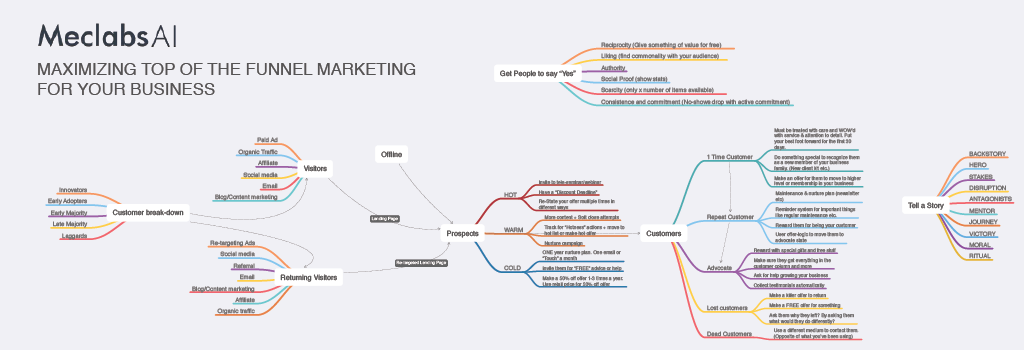Top-of-the-funnel Lead Generation: A visual look at 58 marketing ideas for your customers’ journey
“I’ve put my kids through college with just my ideas.”
A friend of mine who owns an agency told me this over a beer one night. And I think it’s an apt description of a career in marketing.
But here’s the rub – it’s hard to come up with ideas. Day after day. Month after month. Especially if you’ve worked at the same brand for any length of time.
So I’m always looking for ways to get unstuck. And I stumbled across one recently while leading MEC300: Develop Your Creative, an education offering within the AI Guild.
I hesitate to call it a ‘course’ or ‘training’ per se, because I focus the time we have together on interactivity. There’s plenty of content people can dive into between sessions, but during the sessions we review their work building their marketing funnels and – back to that word – help them get unstuck.
While coaching a participant, my co-leader for this track – Dhruv Patel, Chief Product Officer, MeclabsAI (Meclabs is the parent organization of MarketingSherpa) – shared an expansive visual. He took many different concepts he’s learned throughout his career and made one, overarching image that could spur even the most perplexed marketer or entrepreneur to get unstuck.
I’ll show you the visual and then we’ll dive into some of the concepts behind it.

To see a bigger version of this visual, here’s a PDF.
If you’re not familiar with some of the terminology in the visual, let’s take a closer look.
Psychological principles to encourage conversions
Psychological triggers are powerful tools for marketers aiming to influence consumer behavior and encourage conversions. Integrating these principles into your marketing strategies can effectively guide potential customers through the decision-making process. The below are well-known foundational principles of persuasion and influence taught by Dr. Robert Cialdini.
Reciprocity: Offering something of value for free not only captures attention but also instills a sense of obligation, making individuals more likely to engage with your brand in return.
Liking: Finding common ground with your audience fosters a connection, making it easier for them to say “yes” to your offerings.
Authority: Establishing your brand as an authoritative source in your industry builds trust and credibility, key factors influencing consumer decisions.
Social Proof: Leveraging social proof, such as showcasing statistics, testimonials, or endorsements, validates your offerings in the eyes of prospective customers. But beware of social doubt, the downside of social proof in social media marketing.
Scarcity: Creating a sense of urgency through limited availability encourages quicker decision-making and enhances the perceived value of your products or services. Flint McGlaughlin, Founder, MeclabsAI, shows examples of using scarcity both appropriately and inappropriately in The Power of Perceived Value: Discover how a well-marketed banana & roll of tape produced a windfall.
Consistency and Commitment: Encouraging active commitments can significantly reduce no-show rates, as people strive to align their actions with their words.
Crafting a Compelling Narrative
People love stories—they’re how we make sense of the world. To captivate your audience, structure your marketing messages around a compelling narrative. Here’s how you could use a storytelling framework created by Joseph Campbell:
Backstory: Where does your brand come from? What’s the vision?
Hero: Introduce your customers as the heroes who can solve their problems with your help. Here’s an example of making the customer the hero that helped a construction software company increase revenue 53%.
Stakes: What is at risk if they don’t act? Highlight the pain points.
Disruption: How does your product or service disrupt the status quo or improve lives? I’m sure you’ve heard this word a lot lately. It’s not easy, but oh is it powerful. To give you idea, here’s an interview with Harvard Business School professor Thales Teixeira. He shares examples from Uber, Trōv, Best Buy, Telefonica, Fortnite and more.
Journey: Outline the customer’s journey with your product or service. Here’s an example of visualizing the conversion journey.
Victory: Show potential outcomes and successes that customers can expect.
Moral: What larger benefit does your brand provide to the community or world?
Segment your audience for personalized engagement
Understanding your audience is key. Segment them based on their behavior and engagement level:
Hot prospects: Those who show high engagement might be invited to webinars or given limited-time offers.
Warm leads: Engage these users with more content and soft-sell approaches while tracking their readiness to buy.
Cold contacts: Implement a long-term nurture plan with regular touches, such as monthly emails or special annual offers.
Meaningful interactions
Top-of-the-funnel marketing isn’t just about attracting leads; it’s about creating meaningful interactions from the first touchpoint. By providing value upfront, engaging through storytelling, and segmenting your audience to tailor your messages, you can build a solid foundation for customer relationships. This strategic approach not only enhances lead generation but also sets the stage for sustained business growth and profitability.
Categories: Lead Generation top of the funnel









